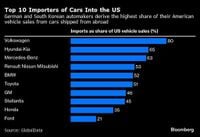The United States has officially lowered tariffs on auto imports from the European Union to 15%, a move that is retroactive to August 1, 2025, and marks a significant step in the ongoing efforts to ease trade tensions between Washington and Brussels. The announcement came on September 24, 2025, when the Department of Commerce and the Office of the US Trade Representative published a detailed document online outlining the changes. This reduction in duties not only affects automobiles but also a range of other goods, cementing terms of a framework trade agreement that the two sides struck nearly two months ago, according to Bloomberg.
The formalization of these tariff changes is especially welcome news for Europe’s auto industry, which has been waiting anxiously for several weeks for the lower duties to be officially adopted. German carmakers, in particular, saw an immediate positive response in the markets. Shares of Volkswagen AG, Porsche AG, and Mercedes-Benz Group AG all rose on the news, with Porsche—one of the hardest hit by previous US tariffs due to its reliance on imports—seeing its shares climb as much as 3.8% in Frankfurt trading, as reported by Bloomberg.
For the European Union, this move comes after a period of negotiation and legislative action. The relief for automobiles and parts was not automatic; it was contingent on the EU introducing legislation to lower tariffs on American industrial goods and certain non-sensitive agricultural products. The EU followed through on this commitment on August 28, 2025, and is currently in the process of implementing its concessions. This paved the way for the US administration to backdate the new auto tariff rate, providing immediate relief to European exporters.
Previously, vehicles imported from the EU faced a 25% US duty on top of a prior levy of 2.5%. These steep tariffs had been a major point of contention between the two economic powerhouses, straining transatlantic relations and threatening to escalate into a broader trade conflict. The new 15% rate represents a substantial reduction and is expected to bolster the competitiveness of European carmakers in the lucrative US market.
Most of the new rates take effect for EU goods shipped starting September 1, 2025, though the relief for automobiles is retroactive to August 1. This retroactive application is particularly significant for companies that had already shipped vehicles to the US, as it allows them to benefit from the lower tariff rate even on recent transactions.
The agreement also sets out a 15% tariff ceiling on most EU exports to the US. According to the terms, this ceiling does not stack on top of any existing industry-specific tariffs. The EU expects that the 15% ceiling will also cover any future sectoral levies that may be introduced, including those on pharmaceuticals and semiconductors. This provision offers a degree of predictability for European exporters, who have faced uncertainty over the possibility of new tariffs being imposed in the rapidly changing landscape of global trade.
Despite this progress, not all areas of transatlantic trade have seen similar breakthroughs. Talks on lowering tariffs on steel and aluminum exports from the EU to the US have made little headway. The European bloc continues to face a whopping 50% duty on its steel and aluminum exports, a point of ongoing frustration for European officials and industry leaders. Other goods that are already subject to tariffs above 15% under Most Favored Nation (MFN) arrangements will also continue to be taxed at those higher levels, Bloomberg notes.
The US notice accompanying the tariff changes made clear that the list of affected products may yet be amended. This leaves the door open for further adjustments as both sides continue to negotiate the finer points of their evolving trade relationship. The move to lower auto tariffs follows an executive order signed earlier in September 2025 by President Donald Trump, which smoothed the process for his administration to adjust tariff rates for imports from economies with which the US has struck trade pacts.
The backdrop to these developments is a broader effort to rebalance trade ties and avoid the kind of painful trade blows that both sides have threatened in recent years. The deal was first announced at one of President Trump’s golf courses in Scotland, a setting that underscored both the high-level political attention and the personal involvement of the US president in the negotiations.
For European automakers, the stakes have been particularly high. The US market represents a major destination for their exports, and the previous 25% tariff—plus the additional 2.5%—had put significant pressure on profit margins and competitiveness. Porsche, for example, sells only imported vehicles in the US and was among the most affected by the higher duties. The relief offered by the new agreement is expected to provide a much-needed boost, not just for manufacturers, but also for workers and suppliers across the European automotive sector.
At the same time, the US has secured concessions from the EU on American industrial goods and some agricultural products, opening up new opportunities for US exporters. The reciprocal nature of the deal is seen as a win-win by many trade analysts, though some caution that unresolved issues—particularly in metals and other sensitive sectors—could yet spark new disputes if not addressed.
Industry observers and policymakers on both sides of the Atlantic will be watching closely as the implementation of the agreement continues. The process is far from over, and the possibility of further amendments to the product list means that companies will need to stay alert to any changes that could affect their business. Still, the lowering of auto tariffs represents a significant step toward reducing trade barriers and fostering closer economic ties between two of the world’s largest economies.
As the EU and US continue to work through the details of their framework trade agreement, the hope is that this latest breakthrough will serve as a foundation for further cooperation and progress on other contentious issues. The formal adoption of lower tariffs on auto imports is a clear signal that, despite the challenges, both sides remain committed to finding common ground and supporting the industries and workers that depend on open and predictable trade.
With this move, the global auto industry and transatlantic trade watchers alike have something to cheer about—at least for now.




